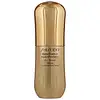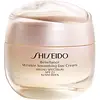What's inside
What's inside
 Key Ingredients
Key Ingredients

 Benefits
Benefits

 Concerns
Concerns

 Ingredients Side-by-side
Ingredients Side-by-side

Water
Skin ConditioningButylene Glycol
HumectantGlycerin
HumectantCyclopentasiloxane
EmollientCarnosine
Skin ConditioningAlcohol Denat.
AntimicrobialMyristyl Myristate
EmollientHdi/Trimethylol Hexyllactone Crosspolymer
Paraffinum Liquidum
EmollientBehenyl Alcohol
EmollientStearyl Alcohol
EmollientGlyceryl Stearate Se
EmulsifyingIsodecyl Neopentanoate
EmollientDimethylacrylamide/Sodium Acryloyldimethyltaurate Crosspolymer
Microcrystalline Wax
Emulsion StabilisingPolysorbate 60
EmulsifyingPEG-40 Stearate
EmulsifyingPhenoxyethanol
PreservativeParaffin
PerfumingParfum
MaskingCitric Acid
BufferingSorbitan Tristearate
EmulsifyingErythritol
HumectantTocopheryl Acetate
AntioxidantSilica
AbrasiveXanthan Gum
EmulsifyingTrisodium EDTA
Panthenyl Ethyl Ether
Potassium Ascorbyl Tocopheryl Phosphate
AntioxidantSodium Metaphosphate
BufferingGlucosyl Hesperidin
HumectantCI 77891
Cosmetic ColorantLimonene
PerfumingLinalool
PerfumingCI 77492
Cosmetic ColorantAlpha-Isomethyl Ionone
PerfumingBenzyl Benzoate
AntimicrobialGeraniol
PerfumingCitronellol
PerfumingSodium Acetylated Hyaluronate
HumectantAluminum Hydroxide
EmollientBHT
AntioxidantWater, Butylene Glycol, Glycerin, Cyclopentasiloxane, Carnosine, Alcohol Denat., Myristyl Myristate, Hdi/Trimethylol Hexyllactone Crosspolymer, Paraffinum Liquidum, Behenyl Alcohol, Stearyl Alcohol, Glyceryl Stearate Se, Isodecyl Neopentanoate, Dimethylacrylamide/Sodium Acryloyldimethyltaurate Crosspolymer, Microcrystalline Wax, Polysorbate 60, PEG-40 Stearate, Phenoxyethanol, Paraffin, Parfum, Citric Acid, Sorbitan Tristearate, Erythritol, Tocopheryl Acetate, Silica, Xanthan Gum, Trisodium EDTA, Panthenyl Ethyl Ether, Potassium Ascorbyl Tocopheryl Phosphate, Sodium Metaphosphate, Glucosyl Hesperidin, CI 77891, Limonene, Linalool, CI 77492, Alpha-Isomethyl Ionone, Benzyl Benzoate, Geraniol, Citronellol, Sodium Acetylated Hyaluronate, Aluminum Hydroxide, BHT
Water
Skin ConditioningGlycerin
HumectantDipropylene Glycol
HumectantButylene Glycol
HumectantBehenyl Alcohol
EmollientSd Alcohol 40-B
AstringentSilica
AbrasiveDimethicone
EmollientIsododecane
EmollientIsohexadecane
EmollientSorbitol
HumectantBeheneth-20
EmulsifyingMyristyl Myristate
EmollientPhytosteryl Macadamiate
Skin ConditioningErythritol
HumectantXanthan Gum
EmulsifyingTocopheryl Acetate
AntioxidantPEG/PPG-14/7 Dimethyl Ether
Skin ConditioningPEG/PPG-17/4 Dimethyl Ether
Skin ConditioningCaffeine
Skin ConditioningSapindus Mukorossi Peel Extract
Skin ConditioningAngelica Keiskei Leaf/Stem Extract
Skin ConditioningCamellia Sinensis Leaf Extract
AntimicrobialCitrus Junos Seed Extract
AntioxidantZiziphus Jujuba Fruit Extract
Skin ConditioningEucheuma Serra/Grateloupia Sparsa/Saccharina Angustata/Ulva Linza/Undaria Pinnatifida Extract
EmollientCurcuma Longa Rhizome Extract
Skin ConditioningPolyquaternium-51
Skin ConditioningSaccharina Angustata/Undaria Pinnatifida Extract
EmollientChlorella Vulgaris Extract
Skin ConditioningPPG-17
Skin ConditioningStearyl Alcohol
EmollientBeheneth-30
CleansingAlcohol
AntimicrobialCarbomer
Emulsion StabilisingCellulose Gum
Emulsion StabilisingTrisodium EDTA
Hdi/Trimethylol Hexyllactone Crosspolymer
Sodium Citrate
BufferingBHT
AntioxidantSodium Metaphosphate
BufferingPotassium Hydroxide
BufferingCitric Acid
BufferingTocopherol
AntioxidantPPG-3 Dipivalate
Skin ConditioningSodium Metabisulfite
AntioxidantPhenoxyethanol
PreservativeParfum
MaskingIron Oxides
Water, Glycerin, Dipropylene Glycol, Butylene Glycol, Behenyl Alcohol, Sd Alcohol 40-B, Silica, Dimethicone, Isododecane, Isohexadecane, Sorbitol, Beheneth-20, Myristyl Myristate, Phytosteryl Macadamiate, Erythritol, Xanthan Gum, Tocopheryl Acetate, PEG/PPG-14/7 Dimethyl Ether, PEG/PPG-17/4 Dimethyl Ether, Caffeine, Sapindus Mukorossi Peel Extract, Angelica Keiskei Leaf/Stem Extract, Camellia Sinensis Leaf Extract, Citrus Junos Seed Extract, Ziziphus Jujuba Fruit Extract, Eucheuma Serra/Grateloupia Sparsa/Saccharina Angustata/Ulva Linza/Undaria Pinnatifida Extract, Curcuma Longa Rhizome Extract, Polyquaternium-51, Saccharina Angustata/Undaria Pinnatifida Extract, Chlorella Vulgaris Extract, PPG-17, Stearyl Alcohol, Beheneth-30, Alcohol, Carbomer, Cellulose Gum, Trisodium EDTA, Hdi/Trimethylol Hexyllactone Crosspolymer, Sodium Citrate, BHT, Sodium Metaphosphate, Potassium Hydroxide, Citric Acid, Tocopherol, PPG-3 Dipivalate, Sodium Metabisulfite, Phenoxyethanol, Parfum, Iron Oxides
Ingredients Explained
These ingredients are found in both products.
Ingredients higher up in an ingredient list are typically present in a larger amount.
Behenyl Alcohol is a type of fatty alcohol (these are different from the drying, solvent alcohols).
Fatty Alcohols have hydrating properties and are most often used as an emollient or to thicken a product. They are usually derived from natural fats and oils; behenyl alcohol is derived from the fats of vegetable oils.
Emollients help keep your skin soft and hydrated by creating a film that traps moisture in.
In 2000, Behenyl Alcohol was approved by the US as medicine to reduce the duration of cold sores.
Learn more about Behenyl AlcoholBHT is a synthetic antioxidant and preservative.
As an antioxidant, it helps your body fight off free-radicals. Free-radicals are molecules that may damage your skin cells.
As a preservative, it is used to stabilize products and prevent them from degrading. Specifically, BHT prevents degradation from oxidation.
The concerns related to BHT come from oral studies; this ingredient is currently allowed for use by both the FDA and EU.
However, it was recently restricted for use in the UK as of April 2024.
Learn more about BHTButylene Glycol (or BG) is used within cosmetic products for a few different reasons:
Overall, Butylene Glycol is a safe and well-rounded ingredient that works well with other ingredients.
Though this ingredient works well with most skin types, some people with sensitive skin may experience a reaction such as allergic rashes, closed comedones, or itchiness.
Learn more about Butylene GlycolCitric Acid is an alpha hydroxy acid (AHA) naturally found in citrus fruits like oranges, lemons, and limes.
Like other AHAs, citric acid can exfoliate skin by breaking down the bonds that hold dead skin cells together. This helps reveal smoother and brighter skin underneath.
However, this exfoliating effect only happens at high concentrations (20%) which can be hard to find in cosmetic products.
Due to this, citric acid is usually included in small amounts as a pH adjuster. This helps keep products slightly more acidic and compatible with skin's natural pH.
In skincare formulas, citric acid can:
While it can provide some skin benefits, research shows lactic acid and glycolic acid are generally more effective and less irritating exfoliants.
Most citric acid used in skincare today is made by fermenting sugars (usually from molasses). This synthetic version is identical to the natural citrus form but easier to stabilize and use in formulations.
Read more about some other popular AHA's here:
Learn more about Citric AcidYou might know this ingredient as a sugar substitute in foods. It is a sugar alcohol with humectant properties.
Humectants attract water to your skin (like glycerin or hyaluronic acid).
Fun fact: Erythritol can be naturally found in some fermented foods.
Learn more about ErythritolGlycerin is already naturally found in your skin. It helps moisturize and protect your skin.
A study from 2016 found glycerin to be more effective as a humectant than AHAs and hyaluronic acid.
As a humectant, it helps the skin stay hydrated by pulling moisture to your skin. The low molecular weight of glycerin allows it to pull moisture into the deeper layers of your skin.
Hydrated skin improves your skin barrier; Your skin barrier helps protect against irritants and bacteria.
Glycerin has also been found to have antimicrobial and antiviral properties. Due to these properties, glycerin is often used in wound and burn treatments.
In cosmetics, glycerin is usually derived from plants such as soybean or palm. However, it can also be sourced from animals, such as tallow or animal fat.
This ingredient is organic, colorless, odorless, and non-toxic.
Glycerin is the name for this ingredient in American English. British English uses Glycerol/Glycerine.
Learn more about GlycerinThis ingredient is a powder used to improve texture, slip, and give products a silky texture.
Myristyl Myristate is created from the fatty acids of myristyl alcohol and myristic acid. In skincare, it is an emollient and texture enhancer.
On its own, this ingredient has a comedogenicity index of 5/5. This means it has the potential to clog pores. When diluted with cetyl alcohol or propylene glycol, the comedogenicity will decrease.
This ingredient may not be Malassezia folliculitis, or fungal-acne safe.
Nutmeg, palm kernel oil, and coconut oil all contain this ingredient naturally.
Learn more about Myristyl MyristateParfum is a catch-all term for an ingredient or more that is used to give a scent to products.
Also called "fragrance", this ingredient can be a blend of hundreds of chemicals or plant oils. This means every product with "fragrance" or "parfum" in the ingredients list is a different mixture.
For instance, Habanolide is a proprietary trade name for a specific aroma chemical. When used as a fragrance ingredient in cosmetics, most aroma chemicals fall under the broad labeling category of “FRAGRANCE” or “PARFUM” according to EU and US regulations.
The term 'parfum' or 'fragrance' is not regulated in many countries. In many cases, it is up to the brand to define this term.
For instance, many brands choose to label themselves as "fragrance-free" because they are not using synthetic fragrances. However, their products may still contain ingredients such as essential oils that are considered a fragrance by INCI standards.
One example is Calendula flower extract. Calendula is an essential oil that still imparts a scent or 'fragrance'.
Depending on the blend, the ingredients in the mixture can cause allergies and sensitivities on the skin. Some ingredients that are known EU allergens include linalool and citronellol.
Parfum can also be used to mask or cover an unpleasant scent.
The bottom line is: not all fragrances/parfum/ingredients are created equally. If you are worried about fragrances, we recommend taking a closer look at an ingredient. And of course, we always recommend speaking with a professional.
Learn more about ParfumPhenoxyethanol is a preservative that has germicide, antimicrobial, and aromatic properties. Studies show that phenoxyethanol can prevent microbial growth. By itself, it has a scent that is similar to that of a rose.
It's often used in formulations along with Caprylyl Glycol to preserve the shelf life of products.
Silica, also known as silicon dioxide, is a naturally occurring mineral. It is used as a fine, spherical, and porous powder in cosmetics.
Though it has exfoliant properties, the function of silica varies depending on the product.
The unique structure of silica enhances the spreadability and adds smoothness, making it a great texture enhancer.
It is also used as an active carrier, emulsifier, and mattifier due to its ability to absorb excess oil.
In some products, tiny microneedles called spicules are made from silica or hydrolyzed sponge. When you rub them in, they lightly polish away dead skin layers and enhance the penetration of active ingredients.
Learn more about SilicaWe don't have a description for Sodium Metaphosphate yet.
Stearyl Alcohol is a type of fatty alcohol from stearic acid. It is a white, waxy compound used to emulsify ingredients.
Fatty Alcohols are most often used as an emollient or to thicken a product. Emollients help soothe and hydrate the skin by trapping moisture.
They are usually derived from natural fats and oils and therefore do not have the same drying or irritating effect as solvent alcohols. FDA allows products labeled "alcohol-free" to have fatty alcohols.
Learn more about Stearyl AlcoholTocopheryl Acetate is AKA Vitamin E. It is an antioxidant and protects your skin from free radicals. Free radicals damage the skin by breaking down collagen.
One study found using Tocopheryl Acetate with Vitamin C decreased the number of sunburned cells.
Tocopheryl Acetate is commonly found in both skincare and dietary supplements.
Learn more about Tocopheryl AcetateWe don't have a description for Trisodium EDTA yet.
Water. It's the most common cosmetic ingredient of all. You'll usually see it at the top of ingredient lists, meaning that it makes up the largest part of the product.
So why is it so popular? Water most often acts as a solvent - this means that it helps dissolve other ingredients into the formulation.
You'll also recognize water as that liquid we all need to stay alive. If you see this, drink a glass of water. Stay hydrated!
Learn more about WaterXanthan gum is used as a stabilizer and thickener within cosmetic products. It helps give products a sticky, thick feeling - preventing them from being too runny.
On the technical side of things, xanthan gum is a polysaccharide - a combination consisting of multiple sugar molecules bonded together.
Xanthan gum is a pretty common and great ingredient. It is a natural, non-toxic, non-irritating ingredient that is also commonly used in food products.
Learn more about Xanthan Gum